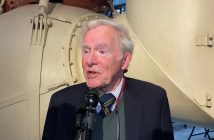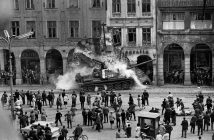On Sept. 17, 1959 – North American test pilot A. Scott Crossfield conducted the first powered flight of the company’s X-15 rocket plane after it was dropped from a highly modified Boeing B-52 bomber designated the NB-52A. The X-15 was the world’s first operational spaceplane and designed to allow the US Air Force and NASA to gather data on hypersonic, high-altitude flight. The aircraft was equipped with aerodynamic controls for atmospheric flight and a reaction control system for use at higher altitudes.
Crossfield was dropped from the mothership at 500 mph and 35,000, accelerating to Mach 2.11 and climbing to an altitude of about 52,341 feet before landing on a dry lake bed. The flight lasted 9 minutes and 11 seconds, but the aircraft was damaged by a hydrogen peroxide fire.
Although the X-15 was designed to be powered by Reaction Motors’ 57,000-pound thrust XLR-99 engine, on its first flight the aircraft was powered by two XLR-11 motors together producing about 15,000 pounds of thrust. While the XLR-99 was the first rocket engine that could be fully throttled, the power of the XLR-11 was controlled by turning each of its four combustion chambers on and off.
Crossfield conducted the first drop test on June 8, gliding the aircraft to a landing.
Three X-15s were built and went on to fly 199 research flights until the program ended in December 1968, setting numerous altitude and speed records. Air Force test pilot Joe Walker set the record for a manned, powered aircraft at Mach 6.72 or 4,520 mph. Eight pilots earned their astronaut wings by flying the X-15 above 50 miles, among them Neil Armstrong, who would later command Apollo 11, the first lunar landing mission.
During flight testing, one X-15 crashed on Nov. 15, 1967, killing Maj. Mike Adams, USAF.
Crossfield’is X-15 is on display at the National Air and Space Museum in Washington, DC.




